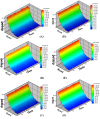Assessment of two hemispherical and hemispherical-conical miniature sources used in electronic brachytherapy using Monte Carlo Simulation
- PMID: 28465817
- PMCID: PMC5410916
- DOI: 10.19082/3845
Assessment of two hemispherical and hemispherical-conical miniature sources used in electronic brachytherapy using Monte Carlo Simulation
Abstract
Introduction: Since the heart of the electronic brachytherapy system is a tube of a miniature x-ray and due to the increasing use of electronic brachytherapy, there is an urgent need for acquiring knowledge about the X-ray spectrum produced, and distribution of x-ray dose. This study aimed to assess the optimal target thickness (TT), the X-ray source spectrum, and the absorbed dose of two miniature sources of hemispherical and hemispherical-conical used in electronic brachytherapy systems, through a Monte Carlo simulation.
Methods: Considering the advantages of MCNPX Code (2.6.0), two input files corresponding to the characteristics of the investigated miniature sources were prepared for this code and then were used for simulation. The optimal thickness (OT) of gold and tungsten targets was determined for the energy levels of 40, 45, and 50 kilo-electron-volts.
Results: In this study, the values of the size of the optimal thickness of 0.92, 1.01 and 1.06 μ for gold target and values of 0.99, 1.08 and 1.34 μ for tungsten target were obtained for energies 40, 45 and 50 keV that using these values, the optimum thickness of 0.92, X-ray spectrum within and outside targets, axial and radial doses for the used energy were calculated for two miniature sources.
Conclusion: It was found that the energy of incident electron, target shape, cross-sectional area of the produced bremsstrahlung, atomic number of materials constituting of the target and output window are the factors with the greatest impacts on the produced X-ray spectrum and the absorbed dose.
Keywords: Dose calculation; Electronic Branchy therapy; Energy Spectrum; Mesh tally; Mont Carlo simulation.
Conflict of interest statement
Conflict of Interest: There is no conflict of interest to be declared.
Figures









Similar articles
-
Characteristics of miniature electronic brachytherapy x-ray sources based on TG-43U1 formalism using Monte Carlo simulation techniques.Med Phys. 2012 Apr;39(4):1971-9. doi: 10.1118/1.3693046. Med Phys. 2012. PMID: 22482618
-
Evaluation of the Effect of Source Geometry on the Output of Miniature X-ray Tube for Electronic Brachytherapy through Simulation.J Biomed Phys Eng. 2018 Mar 1;8(1):29-42. eCollection 2018 Mar. J Biomed Phys Eng. 2018. PMID: 29732338 Free PMC article.
-
Anode optimization for miniature electronic brachytherapy X-ray sources using Monte Carlo and computational fluid dynamic codes.J Adv Res. 2016 Mar;7(2):225-32. doi: 10.1016/j.jare.2015.04.006. Epub 2015 Apr 20. J Adv Res. 2016. PMID: 26966563 Free PMC article.
-
A Monte Carlo-based dosimetric characterization of Esteya® , an electronic surface brachytherapy unit.Med Phys. 2019 Jan;46(1):356-369. doi: 10.1002/mp.13275. Epub 2018 Nov 28. Med Phys. 2019. PMID: 30390317
-
Modeling a hypothetical 170Tm source for brachytherapy applications.Med Phys. 2011 Oct;38(10):5307-10. doi: 10.1118/1.3626482. Med Phys. 2011. PMID: 21992348
References
-
- Herrera R. MCNP5 Monte Carlo based dosimetry for the nucletron iridium-192 high dose-rate brachytherapy source with tissue heterogeneity corrections. Florida Atlantic University; 2012.
-
- Liu DMC. Characterization of novel electronic brachytherapy system. McGill University; 2007.
-
- Dueitt B. Comparisons of External Beam Radiation Therapy, Brachytherapy, and Combination Therapy in the Treatment of Prostate Cancer
LinkOut - more resources
Full Text Sources
Other Literature Sources
Research Materials
